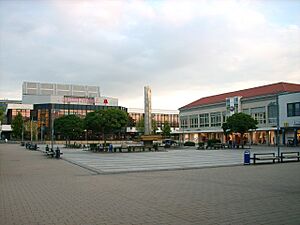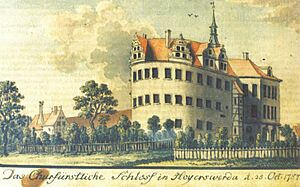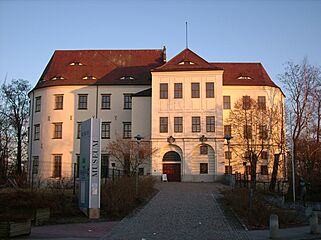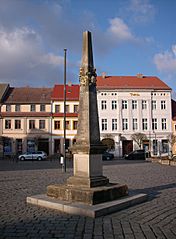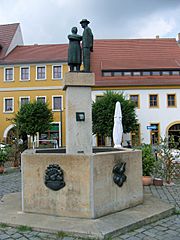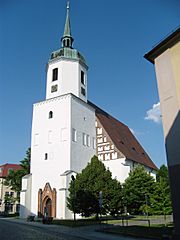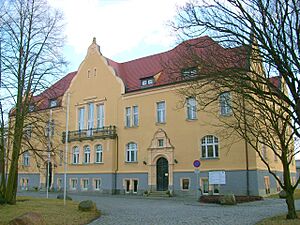Hoyerswerda facts for kids
Quick facts for kids
Hoyerswerda
Wojerecy |
||
|---|---|---|

View of the Old Town's Market Square
|
||
|
||
| Country | Germany | |
| State | Saxony | |
| District | Bautzen | |
| Elevation | 117 m (384 ft) | |
| Population
(2022-12-31)
|
||
| • Total | 31,356 | |
| Time zone | CET/CEST (UTC+1/+2) | |
| Postal codes |
02977
|
|
| Dialling codes | 03571, 035722 | |
| Vehicle registration | BZ, BIW, HY, KM | |
Hoyerswerda (also called Wojerecy in Sorbian) is an important town in the Bautzen district. It is located in the German state of Saxony. The town is part of Upper Lusatia, a region where people speak both German and Upper Sorbian.
Hoyerswerda has two main parts: the Old Town and the New Town. The Old Town is the historic heart, filled with old buildings and interesting places to visit. The New Town is more modern. Before it was updated, it had many prefabricated apartment buildings.
The area around Hoyerswerda is full of lakes, marshes, and rivers. This makes it a popular spot for tourists. Many people come here for holidays, especially cyclists and inline skaters. They enjoy the new paths that wind through the beautiful lake areas.
Contents
Geography of Hoyerswerda
The town is in the northern part of the Bautzen District. It is close to where Saxony meets Brandenburg. Some bigger cities nearby include Cottbus (about 35 kilometers away) to the north-west, Dresden (about 55 kilometers away) to the south-west, and Berlin (about 150 kilometers away) to the north. Hoyerswerda is in Upper Lusatia. It sits on a flat plain with many lakes and some marshy areas.
Town Districts
Hoyerswerda is divided into the Old Town, the New Town, and several other districts. Here are some of them, with their German and Upper Sorbian names:
- Bröthen-Michalken / Brětnja/Michałki
- Dörgenhausen / Němcy
- Knappenrode / Hórnikecy
- Schwarzkollm / Čorny Chołmc
- Zeißig / Ćisk
Old Town Areas
The Old Town of Hoyerswerda has eleven smaller areas:
- Neida
- Dresdner Vorstadt
- Am Bahnhof (meaning 'At the Railway Station')
- Am Stadtrand (meaning 'On the Outskirts')
- An der Neupetershainer Bahn
- An der Thrune
- Innere Altstadt (meaning 'Inner Historic Centre')
- Senftenberger Vorstadt
- Spremberger Vorstadt
- Nördliche Elsteraue
- Südliche Elsteraue
New Town Areas
The New Town of Hoyerswerda is divided into 14 areas:
- Neustadt Zentrum (meaning 'New Town Centre')
- Kühnicht
- Grünewaldring
- Gondelteich (meaning 'Gondola Lake')
- Wohnkomplex I
- Wohnkomplex II
- Wohnkomplex III
- Wohnkomplex IV
- Wohnkomplex V/VE
- Wohnkomplex VI
- Wohnkomplex VII
- Wohnkomplex VIII
- Wohnkomplex IX
- Wohnkomplex X
History of Hoyerswerda
Early Beginnings
The first people settled in this area around 700 AD. They were Milceni Slavs. Many old items from their culture have been found in the Hoyerswerda area.
Around 1000 AD, the first church was built in the town. It was called the Heilige Familie (meaning 'Holy Family'). This church still stands today in the historic center.
Hoyerswerda first appeared on a map of Lusatia in 1150. The town was first officially mentioned in 1268. At that time, the mayor was Hoyer von Vredeberg.
In 1371, it became an official market town. Before this, Hoyerswerda was a very small place. But it grew bigger under the leadership of the new mayor, Karl IV.
The town received special municipal rights on December 19, 1423. This allowed the town to elect its own council.
In the 17th century, the town faced many challenges because of the Thirty Years' War. The number of people living there dropped a lot. However, the population recovered by the end of the century.
In 1624, Hoyerswerda became the capital of the Spremberg district. A few years later, the district changed its name to Hoyerswerda. This showed how important the city was becoming.
By the middle of the 17th century, Hoyerswerda was the largest town in the Lusatian region.
In the 18th century, Augustus II the Strong, who was the King of Poland and an Elector of Saxony, gave the area of Hoyerswerda to Ursula Katharina Lubomirska. She helped the town grow its trade and manufacturing. In 1737, King Augustus III of Poland bought the town from Lubomirska. The King often stopped at Hoyerswerda Castle when traveling between Dresden and Warsaw. A battle called the Battle of Hoyerswerda happened nearby in 1759 during the Seven Years' War.
In 1815, Hoyerswerda became part of the Kingdom of Prussia. It was later moved to the Province of Silesia in 1825. In 1871, it became part of the German Empire with Prussia. A new railway opened in 1873 between Hoyerswerda and Ruhland. This helped the town's economy grow. In 1912, the Domowina, an organization for the Sorbs, was started in the city. In 1918, the Sorbs protested here against policies that tried to make them speak only German. The town became part of the Prussian Province of Lower Silesia in 1919.
Recent Times
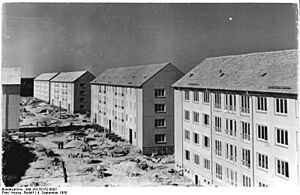
At the end of Second World War, the town was heavily damaged. The Soviet Red Army set parts of the town on fire. After the war, it became part of Saxony again. From 1952 to 1990, it was managed by the Cottbus region.
During the time of East Germany, Hoyerswerda became an important industrial town. A large lignite processing plant called "Schwarze Pumpe" was built in 1955. From 1957, there was a huge need for new homes. Over the next years, ten new living areas were built with thousands of apartments. In 1981, the city had its largest population ever, with over 71,000 residents. At that time, more children were born in Hoyerswerda than anywhere else in East Germany.
When Germany reunited in 1990, the people of Hoyerswerda chose to join the state of Saxony. After East Germany ended, many businesses in the Hoyerswerda area closed or became much smaller.
In 1991, there were difficult events in Hoyerswerda. A hostel for people seeking safety was attacked. These events were widely reported and caused much discussion in Germany and other countries.
Between 1993 and 1998, several smaller villages joined the city. However, the total number of people living in Hoyerswerda quickly went down. It dropped from about 70,000 in the 1980s to about 35,000 by the end of 2012. Efforts have been made to improve the city. Many apartment blocks built during the East German period have been taken down or fixed up. These projects received money from the European Union and Germany.
In 2008, Hoyerswerda stopped being an independently ruled town. This happened because of changes to how Saxony's regions were managed.
Places to See
Here are some of the main sights in Hoyerswerda:
- The Hoyerswerda castle.
- The Market Square (Markt) in the Old Town, which includes:
- The Old Town Hall (Altes Rathaus).
- An 18th-century Polish-Saxon post milestone. It has symbols of Poland and Saxony, and the special mark of King Augustus II the Strong.
- The Sorbian Fountain (Sorbenbrunnen) from 1980.
- The St. John's Church (Johanneskirche).
- The building that used to be the main office of the Domowina, built in 1885.
- The New Town Hall (Neues Rathaus), built in 1904.
- Planetarium Hoyerswerda, which opened in the 1960s.
- The Lusatian Square (Lausitzer Platz) in the New Town. It has the Lusatian Hall (Lausitzhalle/Łužiska Hala).
- The ZCOM Zuse-Computer-Museum.
Local Council Seats
The local council (Stadtrat) makes decisions for Hoyerswerda. Here's how the seats were divided after the 2014 elections:
- CDU: 10 seats
- The Left: 8 seats
- Free voters: 5 seats
- SPD: 4 seats
- AH: 2 seats
- NPD: 1 seat
- Total: 30 seats
Economic Situation
When Hoyerswerda was part of East Germany, many people worked in a power plant, glass factories, coal mines, and an army training area. After Germany reunited, the economy changed a lot. The glass factories and army area closed, and the power plant hired fewer people. This meant many jobs were lost.
Today, the city is hoping for new growth. It is expected that new homes will be needed because of copper mining nearby. There are also plans for a new power plant in Hoyerswerda.
Unemployment in the town is currently around 13%. Also, a study by the Child Protection Alliance showed that Hoyerswerda has a higher rate of child poverty compared to some other places.
Notable People
Here are some interesting people who were born in Hoyerswerda:
- Alfred Otto Herz (1856–1906), an expert on insects.
- Rudolf von Sebottendorf (1875–1945), who started a group called the Thule Society.
- Günter Peters (1907–1987), a painter and zoo director.
- Hermann Mau (1913–1952), a historian and teacher.
- Kurt Klinkert (1927–2004), a painter.
- Gertrud Winzer (born 1940), a politician.
- Rainer Nachtigall (born 1941), a footballer.
- Heinz Kozur (1942–2013), a scientist who studied ancient life forms.
- Rolf Babiel (1952–2009), a famous restaurant owner in New York City.
- Petra Pfaff (born 1960), a track and field athlete.
- Frank Hirche (born 1961), a politician.
- Roland Hennig (born 1967), a racing cyclist.
- Mike Hauschild (born 1972), a politician.
- Marcel Rozgonyi (born 1976), a footballer.
- Krystyna Schreiber (born 1976), a journalist.
- Matthias Heidrich (born 1977), a footballer.
- Evelyn Schmidt (born 1983), who was the German Wine Queen in 2007/08.
- Stefanie Karg (born 1986), a volleyball player.
- Tony Jantschke (born 1990), a footballer.
- Marvin Stefaniak (born 1995), a footballer.
People Who Lived in Hoyerswerda
Some other famous people lived in Hoyerswerda:
- Ursula Katharina Lubomirska (1680–1743), a Polish noblewoman who owned the castle for over 30 years.
- Jan Michał Dąbrowski (1718–1779), a colonel in the Polish Army.
- Jan Henryk Dąbrowski (1755–1818), a Polish general and national hero, who grew up here.
- Konrad Zuse (1910–1995), a computer pioneer, who finished school here.
- Rochus Misch (1917–2013), a radio operator and bodyguard, who trained as a painter here.
- Brigitte Reimann (1933–1973), a writer, who lived here in the 1960s.
- Gerhard Gundermann (1955–1998), a songwriter and rock musician, who lived and worked here.
Twin Towns – Sister Cities
Hoyerswerda has special friendships with other towns around the world. These are called twin towns or sister cities:
 Dillingen, Germany (since 1988)
Dillingen, Germany (since 1988) Huittinen, Finland (since 1998)
Huittinen, Finland (since 1998) Środa Wielkopolska, Poland (since 2006)
Środa Wielkopolska, Poland (since 2006)
See also
 In Spanish: Hoyerswerda para niños
In Spanish: Hoyerswerda para niños



